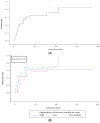Natural History of Pediatric Idiopathic Histaminergic Angioedema: A Retrospective Monocentric Study
- PMID: 40426779
- PMCID: PMC12110337
- DOI: 10.3390/children12050600
Natural History of Pediatric Idiopathic Histaminergic Angioedema: A Retrospective Monocentric Study
Abstract
Background: Idiopathic histaminergic angioedema (IH-AAE) is a pathological entity poorly described in the literature. It overlaps with some forms of chronic urticaria, especially in pediatrics.
Objective: This study is a descriptive analysis of this form of angioedema's natural history and prognosis. The aim is to describe long-term data about the course of this clinical entity, including clinical presentation, recurrence, and response to therapy, emphasizing follow-up and outcome.
Methods: We performed a retrospective monocentric descriptive study at the Allergy Unit, Department of Pediatrics of the Institute for Maternal and Child Health of Trieste, Italy. We selected pediatric patients (0-18 years old) visiting the outpatient clinic from January 2010 to December 2020 who received a diagnosis of IH-AAE. We analyzed the disease recurrence, the remission rate, the time and frequency of recurrences, and the body sites involved.
Results: The median follow-up was 57 months. Among the 36 individuals examined at follow-up, 9 (25%) still had episodes of angioedema, while 27 (75%) reported the absence of attacks. Disease remission was established in 24 patients (66.6%). The median remission time was 13 months (IQR: 7-28). When comparing AE recurrence at onset and follow-up, in all children, the number of episodes decreased (in 4/9 patients) or remained unchanged over time (in 5/9 patients). Moreover, within this group, AE recurrence was recorded as high, intermediate, and low, respectively, in one (11.1%), two (22.2%), and six patients (66.7%). The median number of monthly episodes was one (IQR: 0.2-3), and eight was the maximum value. The initial recurrence of AE attacks has no impact on the time and rate of remission (p = 0.56). According to these data, 36% of the patients will go into remission in 1 year, 54% in 2 years, and 71% in 6.5 years, while 14% of the children will still present with AE after 8 years of disease.
Conclusions: IH-AAE is a benign and self-limiting condition that can sometimes last several years. Over time, the number of episodes per month decreases or, at most, remains unchanged. No patients reported disease worsening. The frequency of attacks at onset does not correlate with the possibility of recovery or the remission time.
Keywords: allergy; angioedema; idiopathic histaminergic acquired angioedema; recurrent angioedema.
Conflict of interest statement
The authors declare no conflicts of interest. The funders had no role in the design of the study; in the collection, analyses, or interpretation of the data; in the writing of the manuscript; or in the decision to publish the results.
Figures
Similar articles
-
Assessment of clinical phenotypic characteristics of patients with angioedema without wheals in a turkish population.Allergy Asthma Proc. 2024 Jul 1;45(4):240-246. doi: 10.2500/aap.2024.45.240034. Allergy Asthma Proc. 2024. PMID: 38982609
-
Association between thyroid autoimmunity and recurrent angioedema in children.Allergy Asthma Proc. 2015 Nov-Dec;36(6):468-72. doi: 10.2500/aap.2015.36.3883. Allergy Asthma Proc. 2015. PMID: 26534752
-
Idiopathic histaminergic angioedema without wheals: a case series of 31 patients.Clin Exp Immunol. 2016 Jul;185(1):81-5. doi: 10.1111/cei.12789. Epub 2016 Apr 13. Clin Exp Immunol. 2016. PMID: 26969870 Free PMC article.
-
Idiopathic Non-histaminergic Angioedema: Successful Treatment with Omalizumab in Five Patients.J Clin Immunol. 2017 Jan;37(1):80-84. doi: 10.1007/s10875-016-0345-7. Epub 2016 Nov 8. J Clin Immunol. 2017. PMID: 27826875 Review.
-
A Retrospective Analysis of Long-Term Prophylaxis with Berotralstat in Patients with Hereditary Angioedema and Acquired C1-Inhibitor Deficiency-Real-World Data.Clin Rev Allergy Immunol. 2023 Dec;65(3):354-364. doi: 10.1007/s12016-023-08972-2. Epub 2023 Nov 2. Clin Rev Allergy Immunol. 2023. PMID: 37914894 Free PMC article. Review.
References
-
- Schulkes K.J.G., Van den Elzen M.T., Hack E.C., Otten H.G., Bruijnzeel-Koomen C.A.F.M., Knulst A.C. Clinical similarities among bradykinin-mediated and mast cell-mediated subtypes of non-hereditary angioedema: A retrospective study. Clin. Transl. Allergy. 2015;5:5. doi: 10.1186/s13601-015-0049-8. - DOI - PMC - PubMed
-
- Reshef A., Buttgereit T., Betschel S.D., Caballero T., Farkas H., Grumach A.S., Hide M., Jindal A.K., Longhurst H., Peter J., et al. Definition, acronyms, nomenclature, and classification of angioedema (DANCE): AAAAI, ACAAI, ACARE, and APAAACI DANCE consensus. J. Allergy Clin. Immunol. 2024;154:398–411. doi: 10.1016/j.jaci.2024.03.024. - DOI - PubMed
Grants and funding
LinkOut - more resources
Full Text Sources


